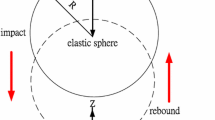Abstract
In this paper, photoelastic experimental hybrid methods using the external traction free boundary condition and that using the relative equation of two stress functions in contact problems are developed. The validities of these two methods are confirmed through experiments and discussions. Hertz’s contact theory and the two photoelastic experimental hybrid methods explained are applied to the analysis of the contact stress of an O-ring under 10% or 20% squeeze rate. The photoelastic experimental hybrid method using the relative equation of two stress functions in contact problems was found to be more effective. When the squeeze rates of an O-ring were 10% or 20%, the maximum of absolute σ x was greater than the maximum of absolute σ y , but was almost equal. Maximums of absolute τ xy were 1/8 of absolute σ x and 1/5 of absolute σ x when the squeeze rates of the O-ring were 10% and 20%, respectively.
Similar content being viewed by others
References
Antonio Strozzi, Static stresses in an unpressurized, rounded, rectangular, elastometric seal, Asle Transactions, 29(4)(1986) 558–564.
E. Dragoni and A. Strozzi, Theoretical analysis of an unpressurized elastomeric O-ring seal into a rectangular groove, Elsevier Sequoia, Wear, 130 (1989) 41–51.
E. Dragoni and A. Strozzi, Analysis of an unpressurized, laterally restrained, elastomeric O-ring seal, Journal of Tribology, 110(1988) 192–300.
A. Karaszkiewicz, Geometry and contact pressure of an O-ring mounted in a seal groove, Ind. Eng. Chem. Res. 29(1990) 2134–2137.
I. K. Lee and C. K. Kim, Numerical simulations on the O-ring extrusion in automotive engines, Journal of Korean Society of Tribologists & Lubrication Engineers, 15(4)(1999) 297–303.
K. K. Chandrashekhara and K. Jacob, Experimental numerical hybrid technique for stress analysis of orthotropic composites, Edited by Holester, Applied Science Publication, (1977) 67–68.
C. W. Smith, D. Post, G. Hiatt and G. Nicoletto, Displacement measurements around cracks in three dimensional Problems by a hybrid experimental technique, Exp. Mech., (1983)15–20.
J. S. Hawong, C. H. Lin, S. T. Lin, J. Rhee and R. E. Rowlands, A hybrid method to determine individual stresses in orthotropic composites using only measured isochromatic data, Journal of Composite Material, 29(18)(1995) 2366–2387.
J. S. Hawong, D. C. Shin and H. J. Lee, Photoelastic experimental hybrid method for fracture mechanics of anisotropic materials, Experimental Mechanics, 41(1)(2001) 92–99.
D. C. Shin, J. S. Hawong, J. H. Nam, H. J. Lee and O. S. Kwon, Application of transparent photoelastic experimental hybrid method for the fracture mechanics of orthotropic material, Transactions of the Korean Society of Mechanical Engineers(A), 22(6) (1998) 1036–1044.
D. C. Shin, J. S. Hawong, H. J. Lee, J. H. Nam and O. S. Kwon, Application of transparent photoelastic experimental hybrid method to the fracture mechanics of isotropic material, Transactions of the Korean Society of Mechanical Engineers(A), 22(5) (1998) 834–842.
D. C. Shin and J. S. Hawong, A study on the development of the dynamic photoelastic experimental hybrid method for isotropic material, Transaction of the Korean Society of Mechanical Engineers (A), 24(9) (2000) 2220–2227.
D. C. Shin and J. S. Hawong, A study on the development of the dynamic photoelastic experimental hybrid method for dissimilar isotropic material, Transactions of the Korean Society of Mechanical Engineers (A), 25(3) (2001) 434–442.
D. C. Shin, J. S. Hawong and J. H. Sung, Development of the dynamic photoelastic experimental hybrid method for propagating cracks in orthotropic material, Transactions of the Korean Society of Mechanical Engineers (A), 27(8) (2003) 1273–1280.
N. I. Muskhelishvili, Some basic problems of mathematical theory of elasticity, 4th Edition, P. Noordhoff Ltd., Groningen Netherlands, (1963).
D. A. Hills, D. Nowell and A. Sackfield, Mechanics of elastic contacts, Butterworth-Heinemann, U.S.A. (1993).
Y. -M. Huang, Determination of individual stresses from thermoelastically measured trace of stress tensor, Dissertation, University of Wisconsin-Madison, U.S.A. (1989).
R. C. Sampson, A Stress-optic law for photoelastic analysis of orthotropic composites, Exp. Mech. 10 (1970) 210–215.
M. S. Bazaraa and C. M. Shetty, Nonlinear programming theory and algorithms, John Wiley & Sons Inc. U.S.A. (1979).
Ruel V. Churchill, James W. Brown, Roger F. Verhey., Complex variables and applications, Third Edition, U.S.A. (1974).
Author information
Authors and Affiliations
Corresponding author
Additional information
This paper was recommended for publication in revised form by Associate
Jai-Sug Hawong received a B.S. degree in Mechanical Engineering from Yeungnam Uni-versity in 1974. Then he received his M.S. degree and Ph.D. degree from Yeungnam University in Korea in 1976 and from Kanto Gakuin University in Japan in 1990, respectively. Prof. Hawong is currently a professor at the school of Mechanical Engineering at Yeungnam University, in Gyeongsan city, Korea. He is currently serving as an vise-president of Korea Society Mechanical Engineering. Prof. Hawong’s research interests are the areas of static and dynamic fracture mechanics, stress analysis, experimental mechanics for stress analysis and composite material etc.
Rights and permissions
About this article
Cite this article
Nam, J., Hawong, J., Han, S. et al. Contact stress of O-ring under uniform squeeze rate by photoelastic experimental hybrid method. J Mech Sci Technol 22, 2337–2349 (2008). https://doi.org/10.1007/s12206-008-0915-6
Received:
Revised:
Accepted:
Published:
Issue Date:
DOI: https://doi.org/10.1007/s12206-008-0915-6




